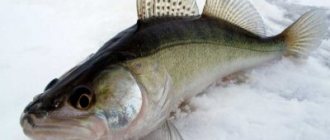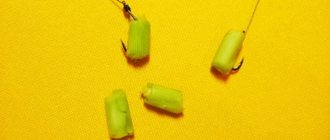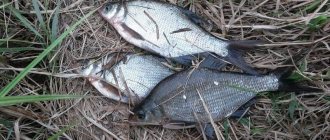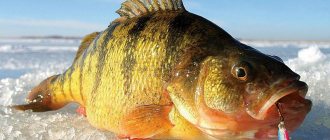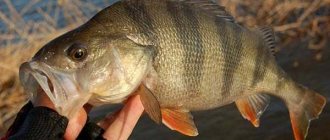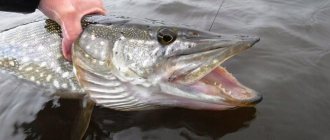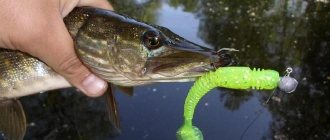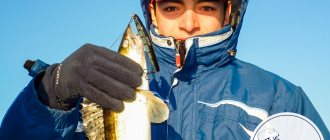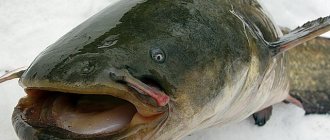Content
- 1 Description and lifestyle
- 2 Habits and biting places
- 3 Tackle and fishing technique 3.1 Catching silver bream on a donk
- 3.2 Catching silver bream with a float rod
- 3.3 Groundbait and attachments for silver bream
- 3.4 Biting and fishing for silver bream
- 4.1 Fishing for silver bream in winter
Description and lifestyle
Gustera
Gustera belongs to the carp family. This is a schooling fish. The body of the silver bream has a silvery tint. The body shape is strongly flattened, and the height is at least a third of the entire length. The nose is blunt in shape and has distinctive large silver eyes. The back has a bluish-gray tint; on the sides of the body there is a bluish-silver color. The unpaired fins have a gray tint, while the paired fins are reddish at the base and dark gray towards the apex. It is worth taking into account that this fish can change due to age, time of year and weather conditions. The silver bream can often be confused with bream, or more precisely the white bream, but the white bream's fins are always gray, while the white bream's are reddish. In addition, the silver bream has larger scales than the white bream.
You can also distinguish silver bream from bream by the number and location of pharyngeal teeth. In the silver bream they are arranged in two rows, five on each side. Gustera almost never grows to large volumes. Most often it is up to 400 g and no more than 30 cm in length. However, sometimes, rather very rarely, you come across a silver bream weighing 600 and 800 grams and weighing about 1.2 kilograms, and even then not in many bodies of water, for example in the Gulf of Finland or Lake Ladoga. It usually feeds on mollusks, algae, worms, insect larvae, and rudd caviar.
The silver bream begins to spawn very late. This often happens at the end of bream spawning, namely at the end of May or early June. During spawning, the scales of the silver bream change color, and the paired fins acquire a more saturated red color. In males at this time, small granular tubercles can be seen along the edges of the scales and on the gill covers, which disappear over time. Typically, small silver bream spawn earlier, and large ones later. In order for the silver bream to be ready for spawning, the water temperature must be between 16-17 °C. White bream can be caught throughout the year, but the best catch will be after spawning.
Groundbait for silver bream
When choosing the composition of complementary foods, you need to take care of its slow dispersion. A briquette of slowly sprayed cake is suitable, or you can add pieces of worms, maggots or small bloodworms to steamed pearl barley. Breadcrumbs should be used to form an attractive cloud. Flavorings are selected experimentally. You can use vanilla, sunflower or hemp oil as a flavoring.
The feeding of complementary foods is carried out into the bottom recesses. On relatively warm days it can be delivered to the pit exits. In addition to the silver bream, roach or bream may also bite in November.
Habits and biting places
The silver bream lives in the rivers and lakes of Europe, in the basins of the North, Baltic, Black, Azov and Caspian seas. In lakes, reservoirs and rivers, the silver bream lives in bays with well-developed vegetation.
Distribution map of silver bream
Silver bream is a fish that inhabits the rivers of the European part of the CIS, belonging to the basins of both the northern and southern seas, where it is especially numerous. In the lower reaches of the Volga it even has a certain economic importance. The silver bream stays in the reservoir in huge flocks and leads a rather “chaotic” lifestyle. It is almost constantly in search of food, living in a variety of places - from the deepest bottom holes to windows among coastal algae. Despite the fact that the silver bream, like the blue bream, lives quite sedentary, without making long-term migrations along the river bed, it is not always possible to predict where it can be found at the moment. This is a consequence of constant feeding.
The silver bream does not have a break to rest; it can be caught both day and night, although some seasonal fluctuations in the bite are also noticeable during the day. Gustera activates after the ice melts. It bites very well after spawning and before laying down in holes in late autumn. If you manage to attack the place where it is staying, then you are guaranteed an absolutely decent catch. True, fishermen are not always happy with such “luck”. The silver bream can discourage other fish from the bait and spoil fishing aimed at catching bream or any other fish. And this phenomenon is quite common, since it absolutely loves bream bait. Despite such “shamelessness,” this fish is still not very trusting and usually stays at a depth of at least 2-3 m. Therefore, during the daytime, the fisherman needs to find just such places, far from the shore, although not at the core itself. It is here that fishing for silver bream can be successful.
How to catch silver bream in the fall
When summer ends, which in Ukraine is noticed only in mid-to-late September, the silver bream begins to form even larger flocks. This happens to her earlier than to her closest relatives, but without pronounced long-distance migrations. Fish simply gather from nearby, relatively shallow places into deeper sections of the river (in holes) or reservoirs (under cliffs and into deep bays). As the shallow waters begin to cool, the silver bream continues to bite in the morning and evening dawns, but the bite is already observed at levels of 2-3 m. But with the rise of the sun, the fish now does not stop feeding, only moving to depths of 3-6 m
Throughout October, the silver bream continues to actively hunt, and its bite gradually spreads throughout almost the entire daylight hours. The fish's desire to feed in the evenings and during the first part of the night prevails over its interest in food before dawn - when biting is possible at the deep site. By the end of October, the silver bream stops moving: it stays in deep (about 6-8 m) areas under cliffs or accumulates in river holes deeper than those in which it spent the day in the summer. At the maximum depth of possible parking, the silver bream is not caught - the lower level of its feeding passes at the marks of 5-6 m - where the growth limit of bottom grasses is located. With the death of aquatic vegetation in the fall, the bite of silver bream seems to wane. But isolated bites observed throughout the day are possible until the reservoir begins to freeze.
Tackle and fishing technique
Catching silver bream on a donk
Bottom gear for catching silver bream is not common. But if you have a high-quality “elastic band” or the rolling “donka”, famous on the southern rivers, such fishing can be effective. White bream mainly feeds from the bottom, which is quite suitable for the capabilities of these gears. They fish with a bottom only if the fish is far from the shore, and the fisherman does not have a boat or it is difficult to get to the fishing spot due to some other factors.
Catching silver bream with a float rod
Float equipment for catching silver bream in weak currents The float rod for catching silver bream must be precisely adjusted. The sensitivity of the tackle is very important when catching this frisky, but not very agile fish. The main line with a cross-section of 0.20 mm should end with a leader no thicker than 0.15 mm. It is necessary to use a composite sinker, and the sub-sink, which should be no more than 2-3 mm in diameter, is placed not farther than 50 mm from the hook. It should be painted white, then it will attract fish no worse than bait: the silver bream is curious and carefully examines everything white for edibility. When fishing from a depth exceeding 3 m, a sliding float is used, which, when combined with a spinning reel, provides high-quality fishing from any depth. Like almost all other fish, the silver bream is susceptible to rain, as well as thunderstorms - at this time a significant increase in biting may be observed.
Groundbait and attachments for silver bream
Feeding gives good results, especially if done a few days before fishing. And when fishing, the presence of a feeder at the fishing point is an almost indispensable element of the hunt for silver bream. It responds well to various plant mixtures intended for attaching carp and crucian carp. They feed the silver bream with the same thing that they will use to fish, but, of course, the quality is worse and in quantities that do not allow the fish to eat. It is best to do this using a feeder installed 1 m from the location of the hook with the nozzle, but slightly upstream.
Baits for catching silver bream depend on the season. In the spring, the fish have a pronounced predilection for bloodworms and dung worms, in the summer for maggots and dough, and in the fall for shellfish meat and jigs.
Silver bream is a rather voracious fish and usually eats a lot of bait (up to 20 liters). It is better to use a feeder for complementary feeding - it is more economical, because You will only need 3-5 liters of bait. Large and heavy particles must be present, because Fishing is carried out on the current, which can carry the food far from the fishing spot.
For silver bream, steamed grains of cereal plants are used, well seasoned with animal additives (bloodworms, maggots). She reacts well to millet and pea porridge with the addition of honey, semolina, pearl barley, oatmeal, and bread. You can use ready-made mixtures for crucian carp, carp, and bream. They begin to bait a few days before fishing.
A characteristic feature of the silver bream is that it immediately swallows the bait, and does not fiddle with it, like many other fish. For bait, you can take worms, bloodworms, bark beetles, burdock moths, pieces of raw perch or the silver bream itself. During the period when insects appear, it is very well caught on beetles, dragonflies, and midges. However, maggot is considered the most effective bait. It also bites well on a jig, regardless of its size and shape. Usually, in a baited area, the bite begins immediately, literally after 1-2 minutes.
Biting and fishing for silver bream
The white bream bite is fast. Already after the first movement of the float, shifting it up or down, as well as in any direction by at least a certain number of millimeters, it is necessary to create an undercut. It is good to do it exactly at the moment the float moves, and not when it stops or dives.
Fishing for silver bream usually does not cause any difficulties. If a particularly large specimen is caught, they act in the same way as when fishing for bream, trying to give the fish a little “take of air.” Then it is transported in the surface layer of water to the boat.
Bait and groundbait
With almost any method of fishing for silver bream, it is highly desirable to use bait and bait. The composition of the bait varies depending on the time of year . In spring and autumn, it should be dominated by animal components (finely chopped worms, shellfish, maggots, bloodworms), in the summer - plant components (porridge, combined ready-made bait, crackers, bread).
For porridges, pearl barley, peas, oatmeal, with the addition of cake, flour, and breadcrumbs are perfect. The bait is mixed with soil, clay, sand on the shore of the reservoir and thrown upstream from the future fishing spot.
It is advisable not to overdo it with bait, since the silver bream, if there is a sufficient amount of food, begins to “be capricious”. As the bait erodes in the water, a trail of turbidity and the food in it is formed, along which the fish approaches the fishing spot 10-20 minutes after placing the bait.
In a feeding area, the silver bream stays for quite a long time and you can catch a lot of it here.
The bait is thrown again only when the bites stop completely, no earlier than an hour after the first cast - this means that the flock has moved away in search of food to another place
Seasonal fishing for silver bream
They catch silver bream throughout the year. In summer it is still quite small, but in late autumn you come across quite worthy specimens. The fisherman needs to know the behavioral characteristics of the silver bream, which combines both cunning and gullibility. She is able to drive away any fish from the bait, but because of her curiosity she often gets hooked herself instead of bream or roach.
Fishing for silver bream in winter
Catching silver bream in winter In winter, silver bream not only accumulates in significant quantities in pits, but periodically comes closer to the shore to summer feeding areas.
It can often be found where the ice is melting due to oncoming currents or springs. In such places it is caught almost all winter. Particular care must be taken to avoid falling through the ice. To do this, before standing on it, check the surface with a pick. The silver bream bites consistently well at the beginning and at the end of freeze-up. After the ice melts, it increasingly comes out onto the coastal shallows and then it can be caught with a float rod. For winter fishing it is better to use thin equipment, because... The fish are inactive at this time and bite rather sluggishly. A 0.08 mm fishing line and a jig the size of a match head are suitable.
When caught on a hook, the silver bream always puts up fierce resistance. Getting it out of the hole can be difficult at times. But if you manage to find a fish site, then you can fully enjoy high-speed and exciting fishing - bites can follow one after another, and the catch will be quite impressive. The joy of such fishing will cover all the inconveniences associated with a long stay in the cold.
Fishing for silver bream in spring
The most promising places for spring fishing are river mouths, large backwaters and bays. Here, especially in windy weather, the water is warmer and the amount of oxygen is maximum. After the winter diet, in anticipation of spawning, the fish begins to actively feed. It is noteworthy that the silver bream goes to the same places to feed every year, regardless of the water level in the spring reservoir.
Even if the water is still very cold, the silver bream already senses spring, much earlier than other fish. It collects most of all at the boundaries of warm and cold water. After the snow melts, it moves closer to streams and tributaries. Gustera does not like muddy water and in the spring prefers areas that are quickly cleared of debris washed away during high water. Most often these are coastal areas with strong soil, where less soil and sand are washed away.
The most promising places are areas near power plants, where a consistently warm temperature regime is constantly maintained. Fishing at shallow depths (less than 1 meter) is not worth it. In spring, the fish still prefer deeper places. And if the weather is cloudy and windless, the necessary mixing of water does not occur. Then the spring bite of silver bream is significantly reduced.
Fishing for silver bream in summer
In mid-May, the spawning of silver bream begins, which ends at the beginning of summer. In June, after a short post-spawning break, the bite resumes. Every day the water becomes warmer, and the silver bream rises to higher layers of water. She always comes out to feed at a certain time, but for each flock this time is different. Therefore, it may seem that the silver bream is biting all day long.
In hot weather, fish are found in the bottom layers during the day, at a depth of 4-6 meters. The silver bream comes to the shallows at night and is almost always near the shore in the early morning. It is attracted to rocky coastal areas with a large amount of algae, where larvae, mollusks, and crustaceans actively develop in the warm season. In addition, other fish often spawn in such places, and the silver bream is not averse to feasting on the eggs of roach or rudd.
The bite increases significantly if there is a short, heavy rain after intense heat. During prolonged bad weather, fishing is unlikely to be successful. Cloudy weather and continuous rain are not for the silver bream. It is very demanding on the oxygen content in the water and often chooses places where there are underwater springs or tributaries flowing in.
Catching silver bream in autumn
With the autumn cold weather, the silver bream goes deeper, and its catching often takes place far from the shore. Having eaten well in the summer, she does not strive to chase food. In autumn, it is more attracted to stationary bait, which makes fishing with a float rod more difficult, but at the same time makes it even more interesting.
From the end of August, the silver bream begins to show greater activity at dusk. She most often spends the night in the depths, and at dawn she appears again in the shallows closer to the shore. Almost always, feeding sites remain traditional: banks with hard soil and vegetation, places on oncoming flows, channels after discharges from dams. For the silver bream, not only the availability of food matters, but also the amount of oxygen, the purity of the water and its temperature.
In late autumn, the silver bream continues to bite at a time when the biting of bream and roach has already stopped. Just before the freeze-up, it can move quite considerable distances, looking for food in an impoverished body of water. At this time, the fish gains good weight, and large specimens of silver bream are caught in late autumn. If you manage to find a school, the catch will be considerable. When stocking up for the winter, fish will bite on almost any bait.
Where is Gustera found?
Regarding its habitat, the silver bream belongs to unpretentious fish. It easily gets along with running and still water; it is not afraid of the relatively dense growth of aquatic grasses and completely open bottom areas; encounters with it even during the same period of the year are possible both in shallow water and at considerable depth.
In rivers, a deepening of the bottom serves as a refuge for it - a reach or hole within a calm riffle and near it; a coastal ledge protecting from the jet near a steep shore; a deep pool or exit from a grassy bay. The composition of the soil is not significant, as long as the bottom is not excessively silty. Herbaceous vegetation attracts fish, which come out to feed at the edge of continuous bottom grasses, almost close to the reeds growing in the water, or stay at moderate depths among thinned out growth. In reservoirs, lakes and some ponds, in addition to areas with developed coastal vegetation along their shores and in bays, the silver bream likes to constantly stay in relatively open areas with a clay bottom. If the bottom slope goes steeply or in stepped terraces into the depths from a steep bank made of clay, then the probability of the constant presence of large representatives of this fish in such a place is very high.
Being a crepuscular fish, which is more evident in the warm season (from late May to late September), and even nocturnal (late June - early August), the silver bream behaves accordingly. Wherever it lives, its migrations to adjacent depth levels are completely dependent on the height of the sun, and the biting time is associated with the absence or dimness of sunlight. The only exception can be considered the middle of spring - when the silver bream sticks to the bays or coastal zone and, except for a few midday hours, bites throughout almost the entire daylight hours, including the earliest and late, “gray” moments of dawn. The depth of spring fishing is limited below by levels of 1.5-3.5 m, and daytime biting near the shore at levels of 1-2 m is not uncommon. After spawning, the silver bream switches to “summer mode” and is seen less and less during the day (with the exception of deep places of permanent parking).
